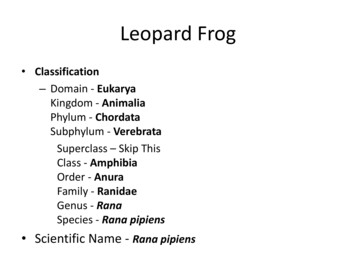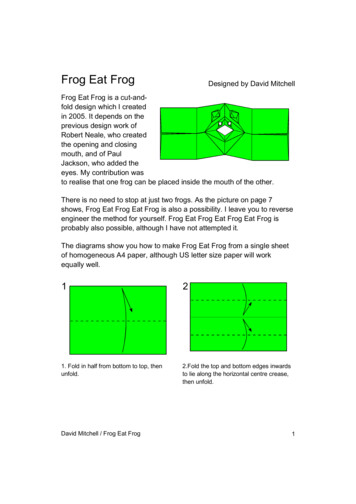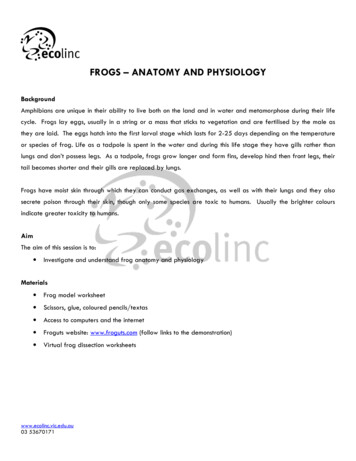
Transcription
Leopard Frog Classification– Domain - EukaryaKingdom - AnimaliaPhylum - ChordataSubphylum - VerebrataSuperclass – Skip ThisClass - AmphibiaOrder - AnuraFamily - RanidaeGenus - RanaSpecies - Rana pipiens Scientific Name - Rana pipiens
Frog Body Parts and Functions
External Anatomy of the Frog
ExternalAnatomyof theFrog
Determine if your frog is a Male or FemaleThe sex of a frog may be determined externally byexamining the thumb pads on the front feet. The thumbpads of males are enlarged at the base as in the drawing onthe right.
External Anatomy of the Frog’s HeadNictating es
Nictating Membrane
Internal Anatomy of the Frog’s HeadInternal NaresMaxillary TeethEsophagusVomerineTeethGlottisEustachiantube openingTongue
Functions of the body parts that make up thefrog’s head External nares or nostrils - Anterior openingsfor the entry or exit of air. Esophagus - Tube that connects the mouthand the stomach in a frog. Tympanic Membrane - The eardrum - receivessound waves Glottis - The opening from the mouth into therespiratory system
Functions of the body parts that make up thefrog’s head Tongue - Muscular structure attached to the frontof the mouth which is extended to catch insects(its food). Maxillary Teeth - Sharp teeth in the maxilla of afrogs mouth that function in holding capturedprey. Vomerine Teeth - Small projections in the top of afrog’s mouth that function in holding andcaptured prey. Eustachian tube openings - Openings in themouth that lead to tubes that connect to themiddle ear to equalize air pressure
Functions of the External Anatomy ofthe Frog Nictitating Membrane - A transparent part of a frog’slower eyelid that moves over the eye to clean it andprotect it. Cloacal Opening - Opening of cloaca through whichundigested food, urine, eggs, and sperm are passed. Vocal Sacs - The vocal sac is the flexible membraneof skin possessed by most male frogs.The purpose of the vocal sac is usually as anamplification of their mating or advertisementcall.
Internal Anatomy
Functions of the Internal Anatomy of aFrog: Stomach - Stores food and mixes it withenzymes to begin digestion. Small Intestine - The principal organ ofdigestion and absorption of digested food. Duodenum - The anterior (front) part of thesmall intestine into which food passes from thestomach Pancreas - Gland which secretes digestiveenzymes into the duodenum. Gall Bladder - Sac which stores bile.
Functions of the Internal Anatomy of aFrog: Large Intestine - Posterior organ of the digestive systemwhich stores undigested food. Liver - Secretes bile and processes digested foodmolecules Urinary Bladder - The organ that collects and stores urineuntil released. Fat Bodies - Masses of fat in the body cavities offrogs. Needed for hibernating and mating Spleen - Organ in the frog’s circulatory system thatmakes, stores, and destroys blood cells. Cloaca - Organ through which the products of the frogsdigestive and urogenital system pass when dischargedfrom the body.
Digestive System
SmallIntestinesLiver
Respiratory System
CirculatorySystem
Anatomy of a Frog Heart
Functions of the Frog Heart Heart - Pumping organ of the circulatory system(has 3 chambers). Anterior Vena Cava - Large vein that carries bloodfrom the anterior part of the body toward theheart. Posterior Vena Cava - Large vein that carriesblood from the posterior part of the bodytowards the heart. Sinus Venosus - Sac that receives blood from thevena cava
Functions of the Frog Heart Right Atrium - Chamber of the frogs heart whichreceives blood from the sinus venosus. Left Atrium - The chamber of the heart thatreceives blood from the lungs. Pulmonary Veins - The blood vessels that carryblood form the lungs to the left atrium. Ventricle - Chamber of a frog’s heart that pumpsblood out of the heart to the lungs and other partsof the body. Truncus Arteriosis - Large artery in a frog thatcarries blood away from the ventricle intobranches that lead to all parts of the body.
Urinary System
Frog Kidneys The kidneys of a frog, like many other animals,filter the blood and excretes excess water. Theureters then carry the urine from the kidneysto the urinary bladder.
Frog Brain
Functions of the Frog Brain Spinal Cord - Main pathway to and from the brain Spinal Nerves - Nerves that lead to and from thespinal cord Olfactory Lobe - Part of the frog’s brain associatedwith the sense of smell Cerebrum - Part of the brain that is associated withmemory, pain, and voluntary muscle control. Optic Lobes - Part of the brain associated withvision.
Functions of the Frog Brain Cerebellum - Part of a brain that influencesbalance and equilibrium. Medulla Oblongata - Part of a brain that is thecenter for some involuntary functions. Cranial Nerves - Nerves that lead to and fromthe brain.
Frog Reproductive System
Frog Reproductive System Functions Urinary Ducts - Tubes in a frog that carry urinefrom the kidneys to the cloaca Urinary Bladder - The organ that collects andstores urine until released. Adrenal Glands - Organs located near thekidneys which secrete hormones. Ova or Eggs - Female sex cell or gametes Fat Bodies - The fat bodies are needed forhibernating, metamorphosis and for mating. These areareas in thebody containing stored energy.
Frog Reproductive System Functions Ovaries - Organs of the female reproductivesystem that produce the eggs. Oviducts - Tubes of a female frog’s reproductivesystem that carry eggs from the ovaries to thecloaca. Testes - Male sex organs that produce sex cells(sperm). Sperm - Male sex cell or gametes. Seminal Vesicles - Enlarged distal sections of themale frog’s urinary ducts that collect sperm priorto entry into the cloaca.
Functions of the Internal Anatomy of a Frog: Stomach - Stores food and mixes it with enzymes to begin digestion. Small Intestine - The principal organ of digestion and absorption of digested food. Duodenum - The anterior (front) part of the small intestine into which food passes from the stomach Pancreas - Gland which secretes digestive










